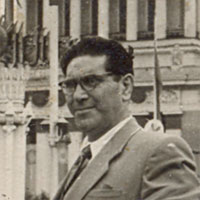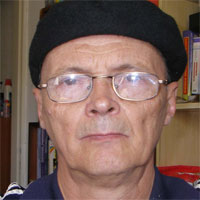You are here
Authors, photos
Samuel Naumovich Kanevsky

Samuel Naumovich Kanevsky (1911 - 1966), physicist, philosopher, encyclopaedically educated scientist.
By his twenty years S.N. Kanevsky received higher education at the Zaporozhye machine-building institute and, possessing a large mental outlook, he received a proposal to conduct studies at courses for raising the level of teachers of physics. Not possessing special knowledge on physics, and constantly being unable to give answers on questions presented by students, he began regular studying of physics. However, also here he did not find answers to apparently simple questions: By which the Sun attracts the Earth? By which a magnet attracts iron bodies? By which a proton attracts electron? By which electrons are kept in an atom orbit? How the atom is arranged? What radiates any heated body? What is light? What is heat?... and so on forth.
After not finding answers to the questions, S.N. Kanevsky independently had been studying works of scientists beginning from Platon, Laplace, Newton up to Lomonosov, Einstein, he was studying philosophers from ancient Greeks to Engels, Lenin by writing out primary sources from the Lenin library in Moscow.
Gradually, he started to form his own opinion on natural phenomena.
So how not to recollect here Albert Einstein, who in response to a question, "Why specifically you created the relativity theory?", answered, "I was not graduated from the university, and I was not taught, how one should be thinking".
By his thirty years S.N. Kanevsky created his own outlook on all questions of natural sciences.
All that outstanding scientists including A.Einstein tried to make all their lives was made by S.N. Kanevsky.
S.N. Kanevsky created a uniform theory, viz. the theory of absoluteness.
Harold Stanislavovich Gurevich

Harold Stanislavovich Gurevich was born in 1937. In 1957 H.S. Gurevich got acquainted with S.N. Kanevsky. By this time, a group of young men interested in questions of philosophy and natural sciences gathered around S.N. Kanevsky. He took a great interest too and joined them.
Studying in the machine-building institute, H.S. Gurevich spent all his free time at S.N. Kanevsky place listening to him and reading works of great physicists. Here he read in the original "Mathematical Principia of Natural Philosophy" by Newton, in the original he got acquainted with M.V.Lomonosov's outlook. He read "Dialectics of nature" by Friedrich Engels, "Materialism and empirical criticism" by V.I. Lenin and much more other things. He began to understand that he was taking a great interest in this subject, and he literally copied a mentality and philosophy of S.N. Kanevsky. Besides, he understood an attitude of scientific world towards S.N. Kanevsky, i.e. an engineer, not a physicist by training. There were also fine responses by scientists - physicists. But the matter did not move forward beyond wishes, instead of help. In his passionate struggle S.N. Kanevsky lost all forces and died very early.
Already at the end of his studies at the institute, H.S. Gurevich understood that there is no other way for him, and he should be engaged in physics professionally. After graduation from the institute in Zaporozhye, the same 1964 H.S. Gurevich entered the faculty of physics of the Lomonosov Moscow State University.
After graduation from the Moscow State University, H.S. Gurevich for more than twenty years has been working in the research institute of nuclear physics at the Moscow State University in laboratory of nuclear reactions. He is a co-author of more than thirty scientific works published in scientific magazines. He participated in scientific conferences on nuclear physics.
Reflecting on a problem of interaction of processes in moving systems of co-ordinates, Mr. Gurevich came to a conclusion that it is impossible to investigate processes in systems of co-ordinates moving between themselves as it was made by A.Einstein in the relativity theory.
It is possible to investigate the processes only in conditionally "motionless" system of co-ordinates arranged out of moving systems of co-ordinates. In books "Matter, space, time, gravitation" and "Dynamics of processes in moving and conditionally "motionless" systems of co-ordinates", H.S. Gurevich stated rules of research of processes in the world around us.
Investigating processes in various fields, H.S. Gurevich understood that the reason of occurrence of force is pressure created by material substance of fields on bodies being in these fields and deduced the uniform formula of interaction of fields and bodies.
Using the uniform formula of interaction of fields and bodies, H.S. Gurevich deduced a formula of force of interaction of fields and bodies.
In his book "Uniform formula of interaction of fields and bodies" there is given a formula of interaction of fields and bodies, and the uniform formula of force of interaction of fields and bodies is deduced.
By means of the uniform formula of force, H.S. Gurevich deduced all formulas of forces received by physicists experimentally (Newton's formula, Coulomb formula, Ohm formula, Ampere formula, etc.).
H.S. Gurevich wrote books: "Matter, space, time, gravitation", "Dynamics of processes in moving and conditionally "motionless" systems of co-ordinates", "Uniform formula of interaction of fields and bodies", "Astrodynamics", "Electrodynamics".
Now there is prepared for publication the section "Microdynamics", including books "Atom physics", "Nuclear physics", "Elementary particles".
Vyacheslav Nikolaevich Choulkov

Vyacheslav Nikolaevich Choulkov is an electronics engineer, programmer. He has two higher education grades. Now he is living in Israel. Also in Israel he got acquainted with H.S. Gurevich. During conversations and after reading the theory of absoluteness, Vyacheslav Nikolaevich understood that the processes investigated in this work and occurring in the macrocosm and microcosm are of great interest for physics and took active part in work on books and on the site.
Figures, graphs, tables for all books of the Theory of absoluteness and on the site are made by Vyacheslav Nikolaevich Choulkov.
The "theory of absoluteness" is presented in the following configuration:
- "MATTER-SPACE-TIME-GRAVITATION". It uncovers the philosophy of thinking of authors.
Philosophy is the mother of all sciences. This ingenious remark defines the approach of scientists to analysis of processes occurring in all areas of knowledge. Only encyclopaedically educated scientist is able to see the unity of laws in macro- and microcosms.
In this book, an analysis is given of thinking of scientists and their understanding of matter, space, time, gravitation.
Definition of matter, space, time, gravitation on the basis of the materialistic positions shared by authors is given. - "ASTRODYNAMICS". In this part, laws of birth, life and death of Galaxies in the Universe and macrobodies in Galaxies are exposed. This book uncovers laws of interaction of macrobodies in Galaxies and Galaxies in the Universe. The internal structure of gravitational field is exposed.
- "ELECTRODYNAMICS". In this part, the internal structure of electromagnetic fields is exposed. The link between electric, magnetic and electromagnetic fields is shown. Formulas of interaction of fields among themselves are deduced. At interaction level of electrons, the internal mechanism of induction, mutual induction and other phenomena is described. The internal mechanism of interaction of electrons is explained during transformation of current and during operation of engines and generators.
- "MICRODYNAMICS". This area of human knowledge is exposed in three books: "ATOM PHYSICS", "NUCLEAR PHYSICS" and "ELEMENTARY PARTICLES".
In these books a strict interrelation of micro- and macrocosm is shown, as well as there is exposed the physical essence of "fields" (gravitational, electromagnetic, nuclear and so forth), with which modern physicists tend to name processes not clear to them and, therefore, compelled to hide behind this mystical word "field".
In the "Theory of Absoluteness ", the laws of macrocosm and microcosm have uniform, logical and mathematically built concept.
